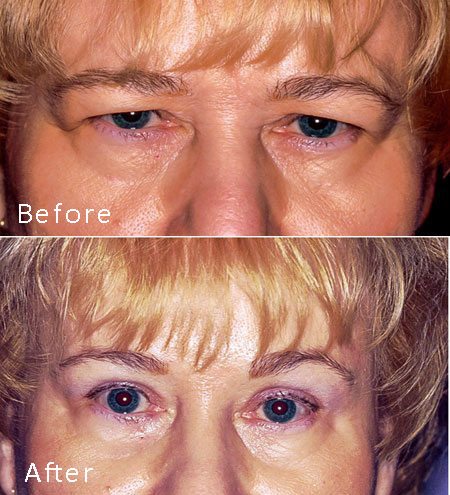Browlift
- There are many ways to elevate brows in patients and the correct procedure is individualized to the patient
- Many men may be a candidate for a browlift through an eyelid crease incision which is hidden
- Endoscopic small incision browlift surgery is very effective
Many patients note “droopy” eyebrows. The position of a patient’s eyebrows not only can affect the visual field but also is frequently a primary clue to others as to one’s mood. Eyebrow position, shape and symmetry create different levels of attractiveness and expression of emotion. The complex interaction of the muscles which move and position the brows often magnifies and focus’ attention on the eyes, thereby conveying our inner feelings. There are many surgical techniques to correct “droopy” eyebrows. These techniques are individualized to the patient’s specific abnormality.
Pre-Operative Evaluation
No one area of the face can be evaluated by itself and this applies to the eyebrows as well. The eyebrows are very important not only in the aesthetics of the face and eyes but also in the proper functioning of the eyes. The preoperative evaluation will include a comprehensive evaluation of the eyes. This includes measurement of visual acuity, evaluation of the tear film and surface of the eye and examination of the upper and lower eyelids. In addition, hair growth and pattern as well as hair treatments will be examined and can determine the surgical approach to a “droopy” eyebrow. The symmetry of the eyebrows and lines of expression in the forehead are also examined. Often significant asymmetry of the eyebrows in expressive patients can not be corrected surgically.
A thorough medical history will be taken and appropriate physical examinations performed. Frequently, patients are asked to have a thorough physical examination by their primary physician prior to surgery. Specific and individualized instructions will be given prior to surgery. All patients are asked to sign a surgical consent form prior to surgery which gives the surgeon your permission to carry out the procedure. We do require that patients have an escort drive you to and from surgery.
The Surgery
Frequently, patients are asked to arrive 1-2 hours prior to surgery. This allows the nursing staff to draw appropriate lab work, start an IV and answer any further questions you may have. An anesthesiologist will discuss anesthesia prior to surgery and answer any questions you may have.
The two most common methods of brow lift surgery involve either an incision across the top of the scalp or the use of an endoscope with smaller incisions. The traditional method or coronal brow lift, involves an incision hidden at or behind the hair line. Once the forehead and brow is released from the underlying bone, the brow can be elevated, the redundant tissue excised and the wound closed. This is an excellent method of achieving elevation of the eyebrows.
The endoscopic brow lift involves the use of 4-5 small incisions behind the hairline. A small scope is inserted through the incisions and the brows are freed from their attachments to the underlying bone. Once the brow is elevated, the scalp is fixated with small absorbable tacks placed into the outer layer of the skull.
Postoperative Care
Most patients have brow lift surgery as an outpatient, though some patients elect to stay one night in the hospital. In most cases, patients experience only moderate discomfort which is easily treated with oral pain medications. All patients are placed on oral antibiotics after surgery for 7 days. Usually, patients are seen 3-7 days postoperatively. Sutures and/or staples are removed between 7-10 days postoperatively. Patients are allowed to wash their hair after 2-3 days postoperatively. It is not uncommon to experience some numbness of the forehead and scalp immediately postoperatively. Because of this, we do not recommend the use of hair dryers postoperatively because of the risk of burning the skin. Patients are started on ice packs 4-6 times daily for the first 5-7 days. Most bruising and swelling will resolve with in 7-10 days at which time patients usually return to work. Final results are usually evident within 3-4 months.
Complications
Eyebrow surgery is very safe and only rarely do significant complications develop. The risks of eyebrow surgery include but are not limited to the following: bleeding, infection, scarring, loss of sensation, hair loss, asymmetry, loss of muscle or nerve function and recurrence of the original “brow droop”.

